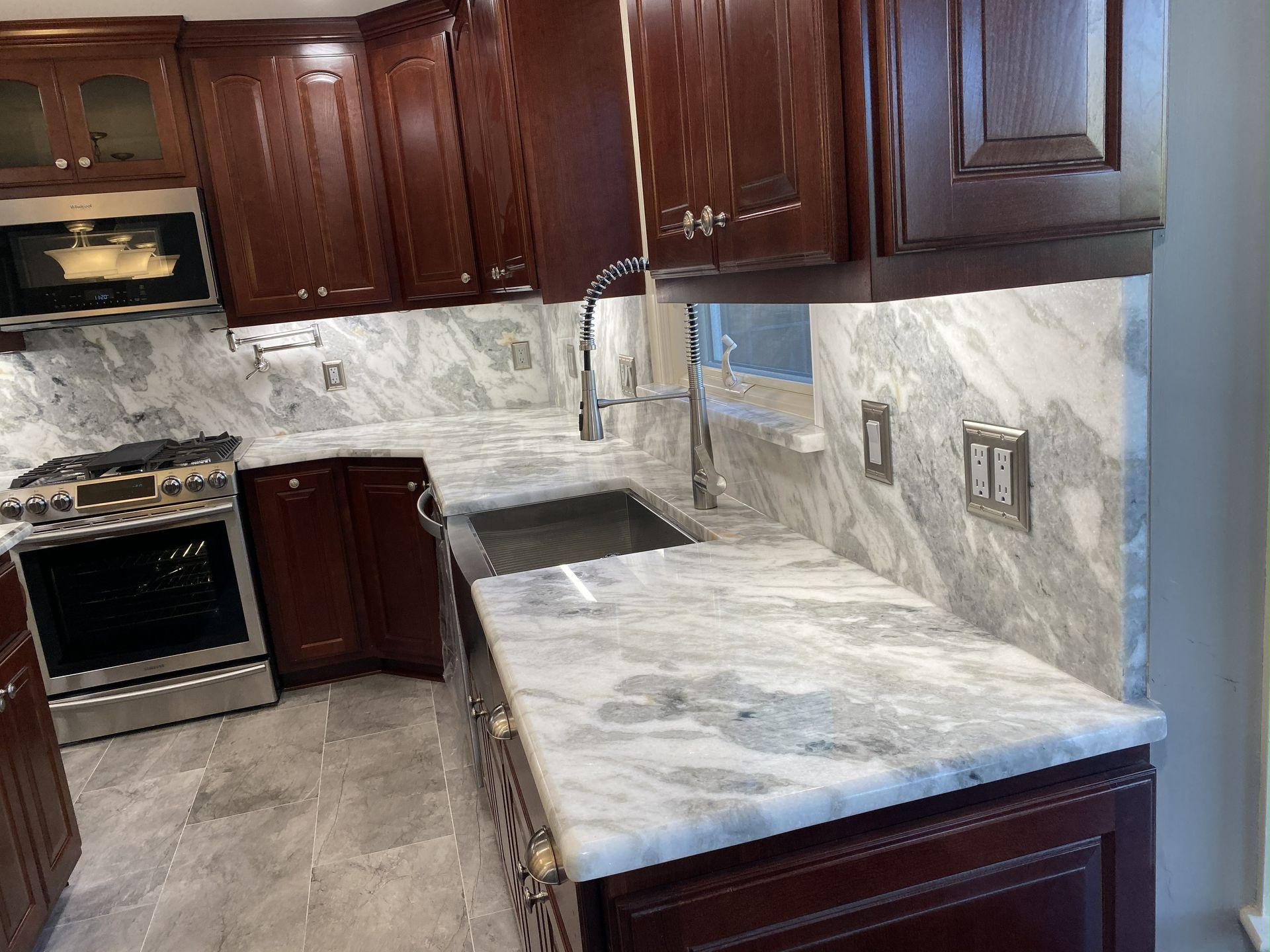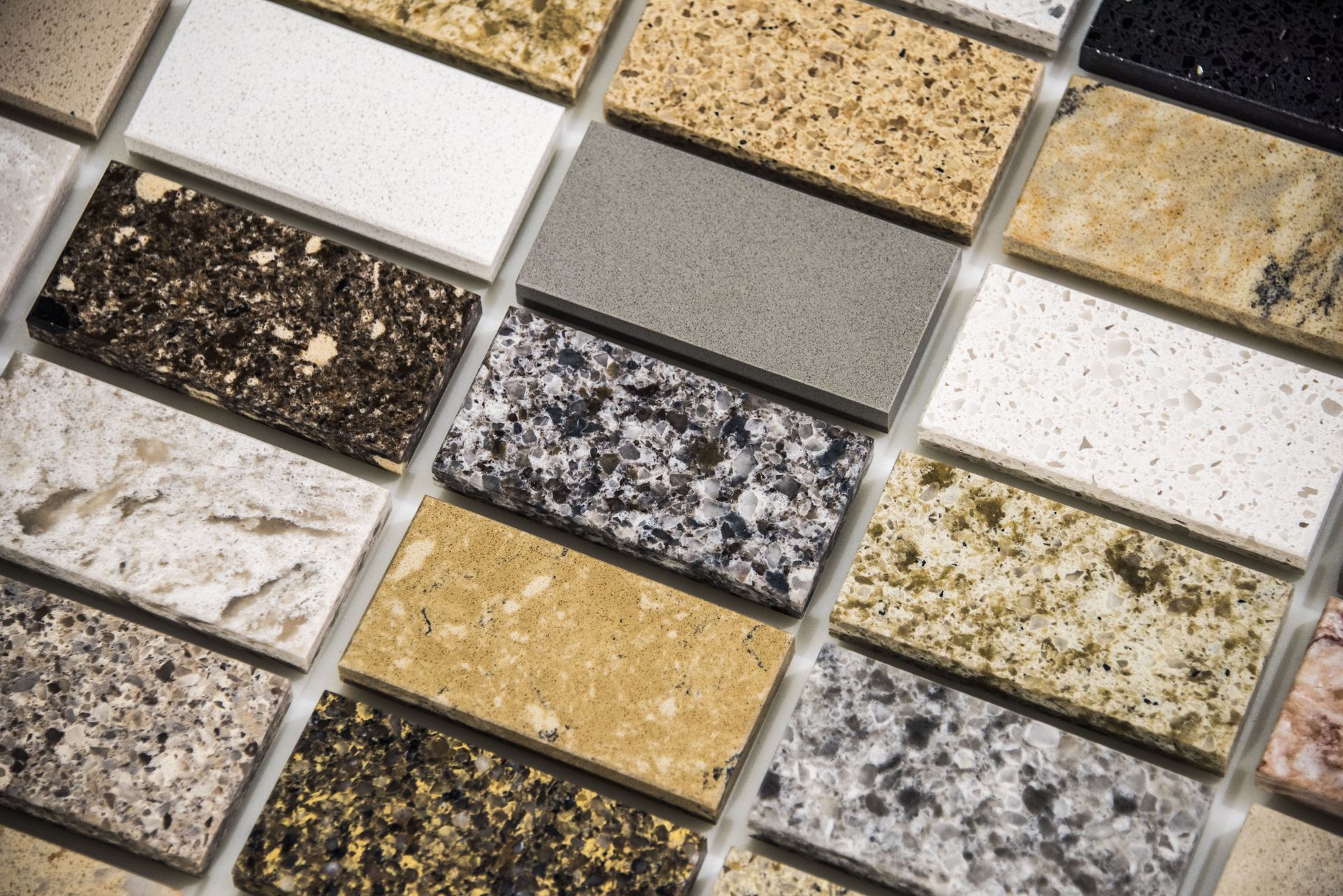The Ultimate Guide to Countertop Backsplashes for Kitchens and Vanities
June 16, 2025
Stylish Solutions, Smart Choices: Everything You Need to Know About Designing the Perfect Backsplash

What is a Backsplash?
A backsplash is a vertical surface located directly behind a countertop. Its primary function is to protect the wall from water, grease, splashes, stains, and heat that may come from the sink, stove, or vanity. But backsplashes are no longer just practical; they are also an aesthetic feature that can enhance your space.
Backsplashes come in various materials, such as tile, marble, granite, quartz, and even metal or glass, and they can be customized in many ways to suit your design preferences.
Types of Countertop Backsplashes
When selecting a backsplash, one of the first things you'll need to consider is the height. There are three main types of backsplash heights: 4-inch, 5-inch, and full-height. Each has its advantages and unique qualities. Let’s dive into each one.
4-Inch Backsplash: The Traditional Choice
The 4-inch backsplash is the most traditional option and has been a popular choice in kitchens and bathrooms for many years. This option features a short vertical rise—typically around 4 inches—above the countertop.
Pros:
- Simple and Subtle: The 4-inch backsplash provides a clean, subtle look without drawing too much attention. It complements a wide range of countertop materials and finishes.
- Budget-Friendly: It requires less material compared to taller backsplashes, making it a more affordable option for homeowners.
- Easy to Maintain: The smaller size makes it easier to clean and maintain, especially if you don’t have a lot of wall space behind the countertop.
Cons:
- Limited Protection: While a 4-inch backsplash protects against minor splashes and spills, it may not be enough to safeguard the wall from extensive moisture or grease, especially in high-use kitchens.
5-Inch Backsplash: The Perfect Middle Ground
The 5-inch backsplash offers a slightly higher barrier compared to the 4-inch version, providing a little more protection while still maintaining a traditional aesthetic.
Pros:
- Moderate Height: With just an extra inch, a 5-inch backsplash offers a better level of protection than the 4-inch, particularly for areas near sinks.
- Classic Look: The 5-inch height still retains a low profile but gives you a bit more flexibility with design choices, allowing for larger or more intricate tile patterns without overwhelming the space.
- Increased Durability: This additional inch can help prevent water and other elements from splashing up onto the wall, especially in kitchens where food prep or washing dishes is common.
Cons:
- Still Limited Coverage: Although the 5-inch backsplash offers more coverage, it still may not be enough for areas with a lot of moisture, like behind stoves, unless paired with a larger backsplash.
Full-Height Backsplash: A Bold Statement
Full-height backsplashes extend all the way up from the countertop to the bottom of the cabinets, covering the entire wall. This option is increasingly popular in modern kitchen and vanity designs, as it creates a seamless, cohesive look.
Pros:
- Maximum Protection: A full-height backsplash provides complete protection from water, grease, stains, and other spills, making it ideal for high-traffic areas in kitchens or vanities.
- Eye-Catching Design: With a full-height backsplash, you can create a dramatic visual effect, whether using tiles, marble, or even a matching countertop material. This type of backsplash is perfect for those who want to make a design statement.
- Easier to Clean: Because the backsplash extends all the way up, cleaning becomes a breeze, and there's no worry about moisture seeping into the wall.
Cons:
- Higher Cost: Full-height backsplashes can be more expensive due to the increased material usage and labor required. If you're using high-end materials, this could increase the cost significantly.
- Can Be Overwhelming: In smaller kitchens or bathrooms, full-height backsplashes may feel too overpowering, especially if the room is already busy with patterns, colors, or textures.
Which Backsplash Height is Right for You?
Choosing the right height for your backsplash depends on several factors, including the style you're aiming for, your functional needs, and your budget. Here’s a quick guide to help you decide:
Opt for a 4-inch backsplash if you’re going for a more traditional, budget-friendly look and want a subtle transition between the countertop and the wall. It’s ideal for spaces with lower moisture concerns or when you’re working with a statement countertop material.
Choose a 5-inch backsplash if you want a little more coverage without the commitment of a full-height option. This middle-ground height works well in kitchens and vanities that experience moderate use and is great for adding visual interest without overwhelming the space.
Go for a full-height backsplash if you want to make a bold statement or need extra protection against moisture, grease, and stains. This choice is perfect for high-traffic kitchens or bathrooms where functionality and style are both important.
Final Thoughts
Your choice of backsplash height should align with both your design vision and practical needs. Whether you’re going for a traditional, minimalist feel with a 4-inch backsplash or a dramatic, protective full-height backsplash, there’s no wrong choice—just the one that works best for you. With endless materials and design possibilities to choose from, your backsplash can be an exciting opportunity to bring your kitchen or vanity to life!
The body content of your post goes here. To edit this text, click on it and delete this default text and start typing your own or paste your own from a different source.

When planning your kitchen or bathroom countertops, one detail that often gets overlooked—but makes a big difference—is the backsplash. A backsplash is the vertical section of material installed on the wall directly behind your countertop. Its primary purpose is to protect your walls from water, grease, soap, and other everyday splashes, while also creating a clean, finished look that ties your design together. Why a Backsplash Is Important? Everyday tasks like washing dishes, cooking, or brushing your teeth can result in water, grease, and other debris hitting your walls. Without a backsplash, moisture can seep into the drywall over time, causing stains, damage, or even mold. A backsplash acts as a protective barrier, keeping your walls safe and making cleanup easier. Beyond protection, backsplashes enhance the overall look of your countertops. They create a smooth transition from counter to wall and add a polished, professional appearance to your kitchen or bathroom. Backsplash Heights and Options At MGL Granite, we can create backsplashes at any height to fit your design needs: Standard 4-Inch Backsplash: The industry standard is typically a 4-inch backsplash. It provides just the right amount of protection behind the countertop while maintaining a simple, timeless look. Full-Height Backsplash: Full-height backsplashes are more common in kitchens, especially behind ranges or sinks. They extend from the countertop up to the bottom of the cabinets—or even to the ceiling—creating a seamless, elegant look. Custom Wall Pieces: We can also fabricate custom backsplash pieces for walls, vanities, or other surfaces where a standard height might not fit your design. This flexibility allows you to achieve a truly personalized, high-end finish. Tile Backsplashes Some homeowners choose tile backsplashes for color, texture, or pattern. While tile can be beautiful, MGL Granite does not provide tile installation. However, we’re happy to coordinate with your tile installer to ensure a perfect fit where the countertop meets the wall. Finishing Touches That Make a Difference Choosing the right backsplash is about more than style—it’s about functionality and protecting your investment. Whether you prefer the simplicity of a 4-inch standard, the dramatic look of a full-height backsplash, or a custom piece to fit your walls, MGL Granite can fabricate and install the perfect solution for your space.

Granite is one of the most popular choices for kitchen and bathroom countertops—and for good reason. It's durable, beautiful, and timeless. But like any natural stone, granite needs a little care to keep it looking its best. One of the most important steps in maintaining granite countertops is sealing them. In this post, we’ll walk you through the basics of sealing granite, why it’s so important (especially for countertops that get regular use), and how MGL Granite can help. Why Does Granite Need to Be Sealed? Granite is a natural stone with a porous surface. That means that if it's left unsealed, liquids like water, oil, wine, or juice can seep into the stone, causing stains or even long-term damage. Bacteria can also find their way into those tiny pores, which isn’t something you want on your food prep surfaces. Sealing your granite countertops helps create a protective barrier that: Repels moisture and spills Prevents staining Makes cleaning easier Extends the life and beauty of your countertops How Often Should You Seal Granite? It depends on the type of granite, how much use your countertops get, and the type of sealer used. Some granite varieties are denser and require sealing less often, while others are more porous and need more frequent attention. As a general rule: Seal high-use kitchen countertops once a year. For less frequently used areas (like guest bathrooms), every 2–3 years may be enough. Pro Tip: Not sure if it's time to reseal? Drip a few drops of water on the surface. If it beads up, you're good. If the water soaks in, it's time to reseal. How to Seal Granite Countertops: Step-by-Step 1. Clean the Surface Thoroughly: Wipe down your granite with a gentle stone cleaner or warm soapy water. Remove all residue and let it dry completely before sealing. 2. Choose the Right Sealer: Use a granite-specific penetrating (or impregnating) sealer that soaks into the stone to provide long-lasting protection. 3. Apply the Sealer: Follow the instructions on the label. Typically, you'll a pply the sealer evenly with a clean cloth or applicator pad. Let it absorb for about 15–20 minutes. Wipe off any excess with a clean, dry cloth 4. Let It Cure: Most sealers cure within 24 hours. During this time, avoid using the surface or getting it wet. Want a Professional to Handle It? We've Got You Covered! At MGL Granite, we don’t just install granite—we help you maintain it. We offer professional granite sealing services, so you don’t have to worry about the mess or guesswork. Whether you need sealing for a newly installed countertop or want to refresh an older surface, we’re here to help. Keep Your Granite Looking Great for Years Sealing your granite countertops is a simple step that goes a long way in protecting your investment. With regular maintenance—or a visit from our team—you can enjoy the beauty and durability of your countertops for decades to come. Contact us today to schedule your sealing service or ask about the best care plan for your countertops!



Share On: